BEST Giardiniera Recipe (Spicy or Mild)
This post may contain affiliate links. See my disclosure policy.
Not just for hot dogs and muffuletta sandwiches, add this homemade giardiniera to your burgers, nachos, pizzas, pasta salads and anything else your heart desires! This Italian giardiniera recipe is simply the BEST (just check out the rave reviews below). I promise, once you’ve tried this you’ll be hooked for life!
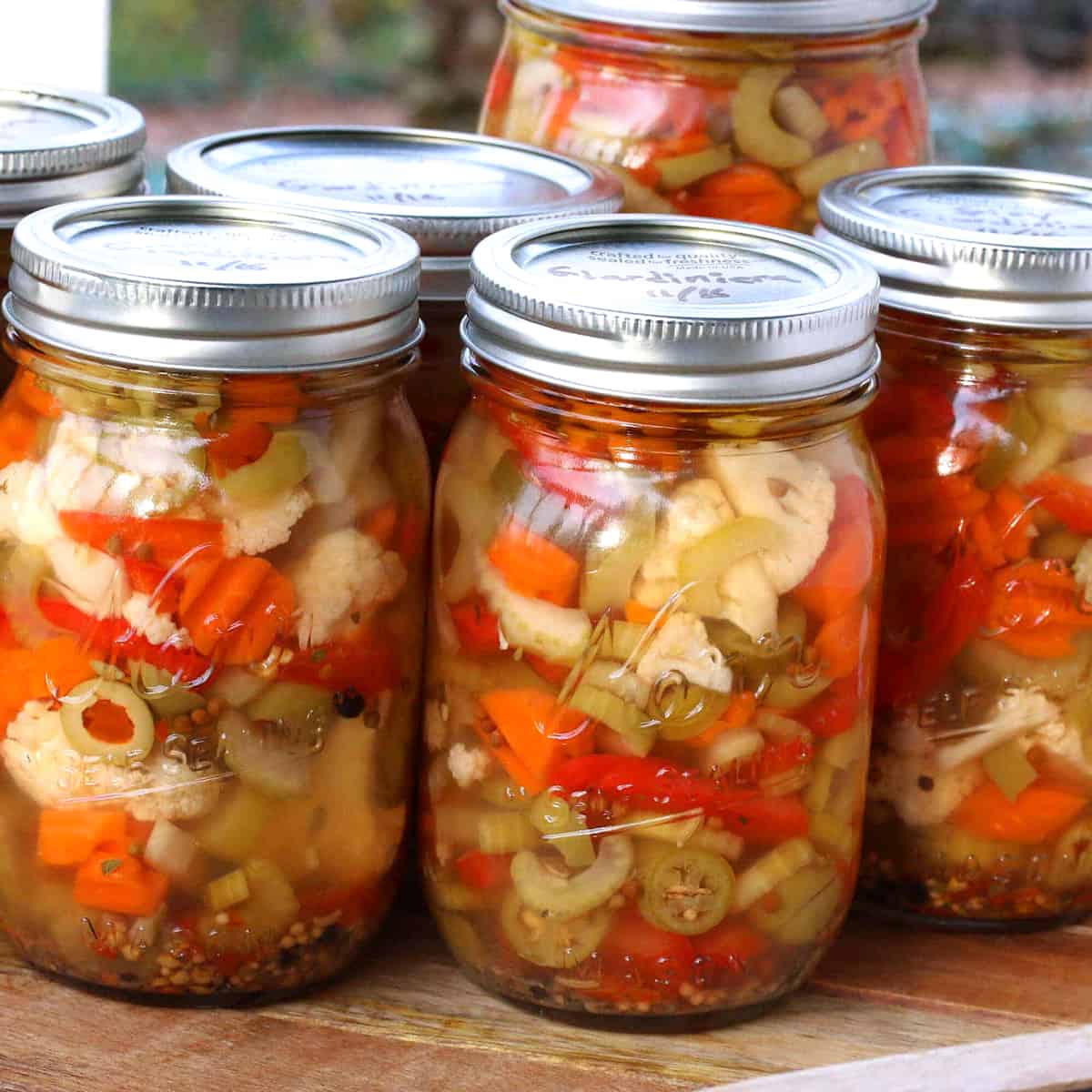
What is Giardiniera?
Giardiniera, pronounced “jar-din-air-ah”, is one condiment you don’t want to be without. It’s one of my favorites and once you’ve tried it I’m confident you’ll fall in love with it too. Originating in Italy, these pickled vegetables were introduced to Chicago in the late 19th century by Italian immigrants and took their place as arguably the city’s most popular condiment. It’s used on practically everything! You name it, giardiniera is just what you need to bring your hot dogs, burgers, sandwiches, nachos, antipasto platters and pasta salads to life. In Chicago you’ll even commonly find it served on pizzas and, of course, no Italian beef sandwich is complete without it. Have you been to New Orleans? Giardiniera is the magical ingredient in those mouthwatering muffuletta sandwiches. In short, giardiniera is the ultimate pickled vegetable relish!
The popularity of giardiniera has continued to grow in Chicago with more than a million pounds of it being sold annually. Still it remains relatively unknown outside of the Windy City except among those with strong Italian roots. So if you’ve never heard of or tried it before, now is your chance to make some absolutely delectable homemade giardiniera that will bring new life and flavor to your favorite foods!
Giardiniera Ingredients & Variations
This giardiniera recipe lends itself easily to any adjustments you’d like to make to suit your tastes, whether it’s adding or swapping vegetables or seasonings. Here’s what you’ll need to make this homemade giardiniera recipe:
- Vegetables: I’m using serrano peppers in this but you can also use jalapenos. You can customize the heat level by adding more or less. We’re also adding a couple of red bell peppers to mix for sweetness and a pop of color. Other vegetables in classic giardiniera are cauliflower, carrots, celery, and some pitted green olives (I love the brininess they contribute). Feel free to add other vegetables if you like, for example pearl onions and green beans.
- Vinegar and Oil: We’re using an equal amount of white wine vinegar and water, which is the right ratio for making this giardiniera recipe safe for canning if you so choose. The white wine vinegar contributes a great flavor and isn’t as harsh as white vinegar. In addition we’re topping off the jars with a little olive oil. If you’re not canning the giardiniera you can add more.
- Seasonings: Garlic is a must. For the spices I really love the combination of oregano, coriander seeds, yellow mustards, fennel seeds, black peppercorns, red pepper flakes, celery seeds and bay leaf. Feel free to change up the ratios or experiment with other spices and herbs like cloves, allspice berries or juniper berries.
You can chop the veggies however large or small you prefer. In Italy the vegetables are usually left in fairly large pieces and that way it’s also more versatile. Left in larger pieces you have the flexibility of serving the giardiniera with your charctuerie/antipasto platters and when you want to use it for sandwiches, hot dogs, pasta salads, etc, you can simply diced up the finished giardiniera into smaller chunks. But left large or diced small, you are simply going to LOVE this giardiniera!
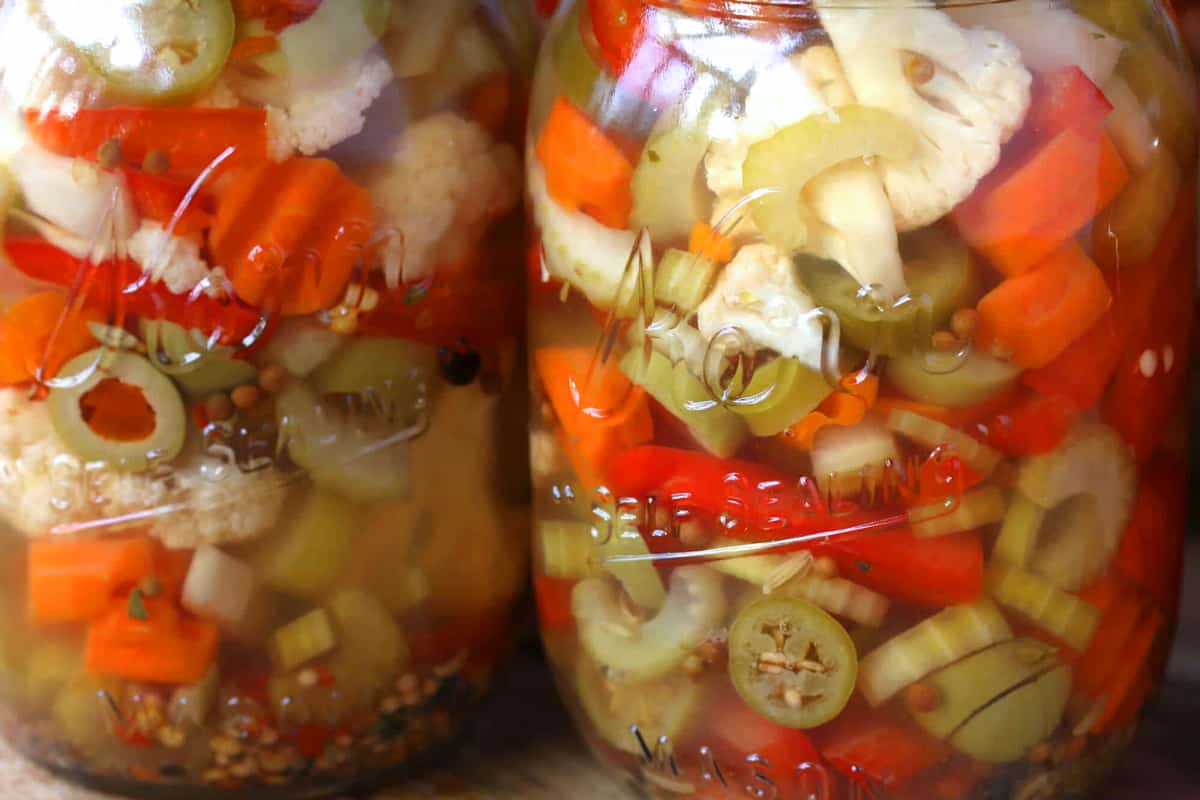
Giardiniera Recipe
Let’s get started!
Chop up the veggies and place them in a large non-reactive pot or bowl. If you’re wondering how to get the crinkle-cut carrots, use a mandolin slicer that has that ability.
Pour 1/4 cup kosher salt over the vegetables.
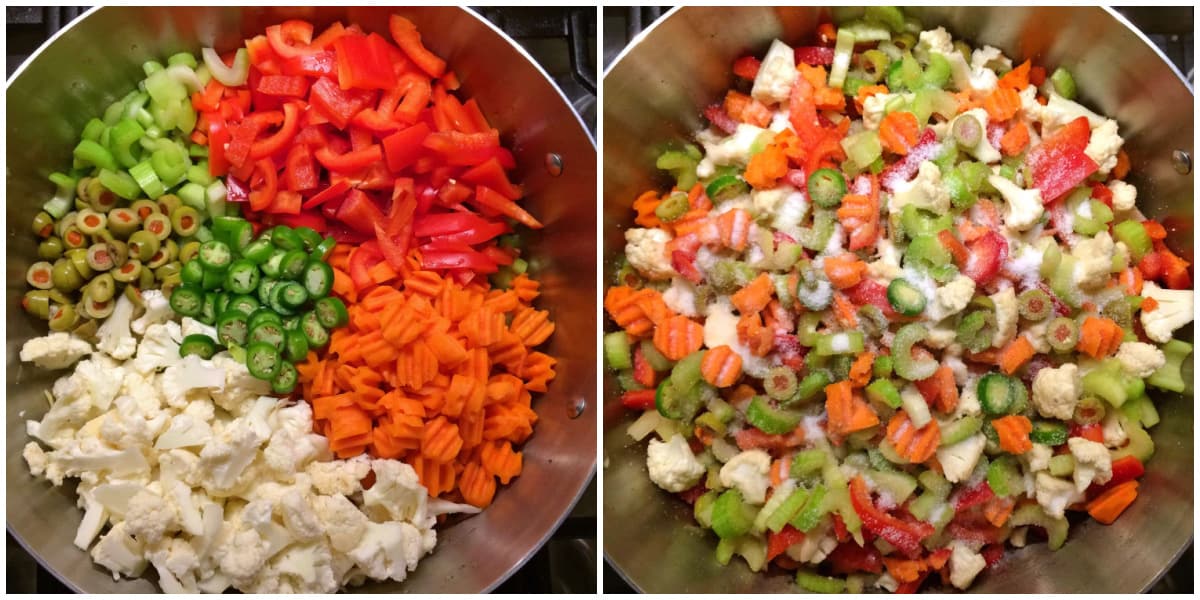
Pour enough water over the vegetables to cover them. Let them soak in the salt water for at least 6 hours or overnight. This step is critical for drawing out excess water from the vegetables which would otherwise dilute the vinegar brine and lead to spoilage.
To prepare the jars, place the spices into each of the jars. I like to make some batches hot and some mild. Do that by using or omitting red chili flakes. For a true Chicago-style giardiniera you’ll want to make it hot!
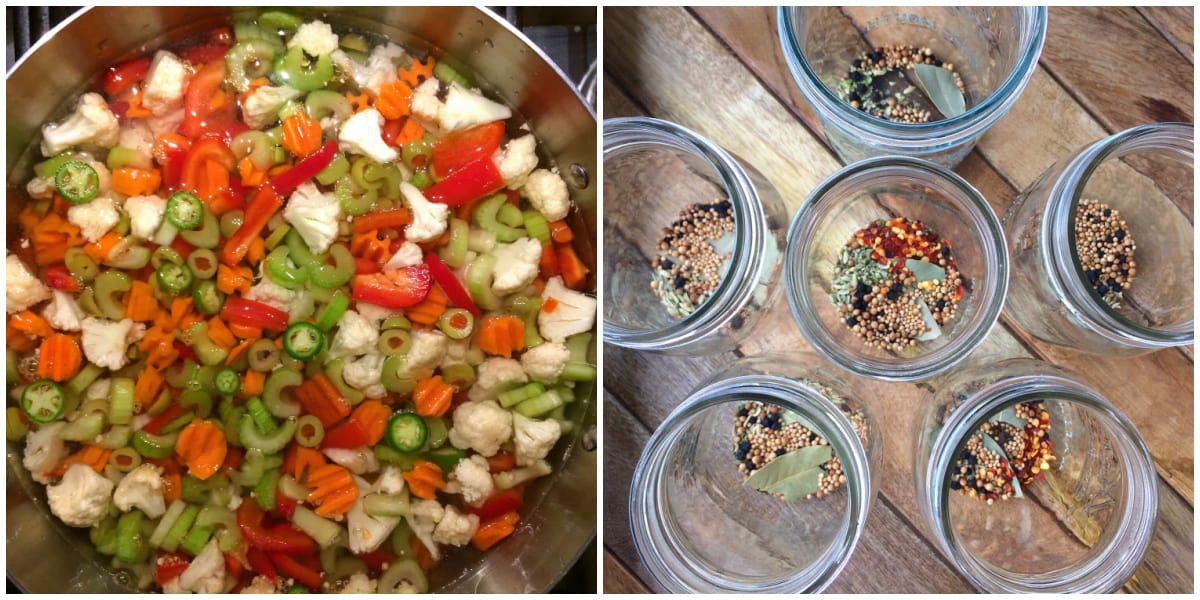
Thoroughly rinse and drain the vegetables before dividing them up between the jars. Pack the vegetables in as tightly as you can. Place the garlic each jar.
Now we’re making a vinegar solution to pickle the vegetables. To play it safe Cooperative Extension Service sources recommend a 1:1 ratio of vinegar to water. Some other recipes may have a lighter vinegar brine but if you’re planning on storing your giardiniera for more than 2 weeks, we recommend this ratio to create enough acidity to prevent the risk of unwanted bacteria.
Bring the water, vinegar and salt to a boil.
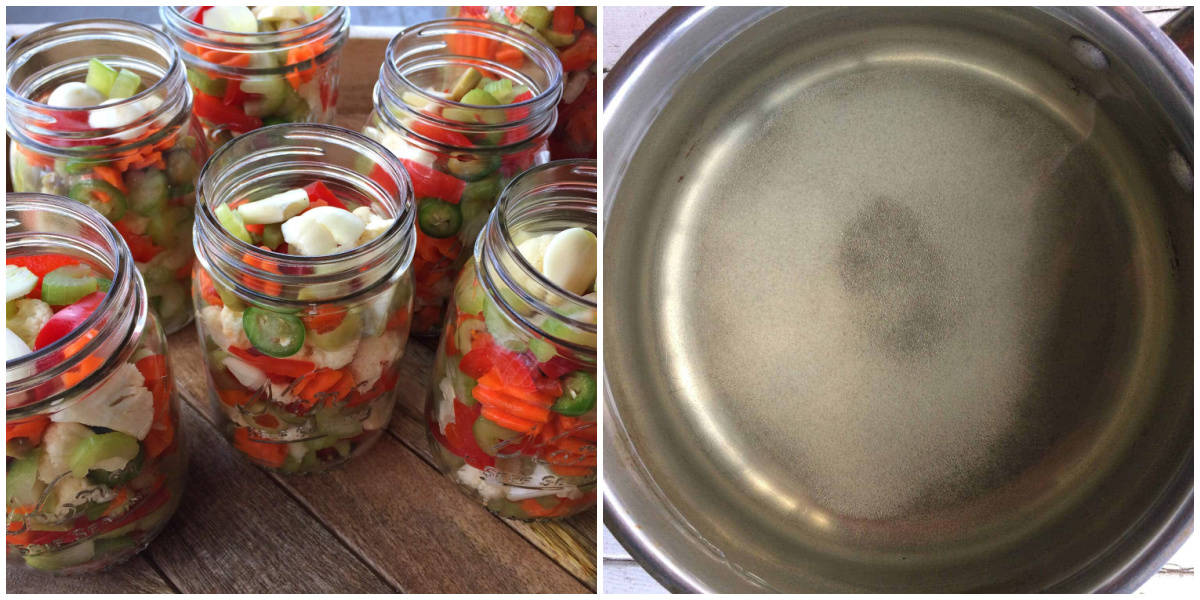
Pour the boiling brine over the vegetables leaving a little more than 1/2 inch headspace from the top. Pour the olive oil over the top. **Omit the oil if you are proceeding with water bath canning the jars. Wipe the rims with a wet paper towel and seal the jars.
If you plan on using the giardiniera within two weeks let the jars sit at room temperature for a day or two and then transfer them to the fridge.
How to Can Giardiniera
As with other pickled vegetables, giardiniera can be canned using the water bath canning method which will enable you to store it long-term to enjoy all year round. No need to pull out the pressure canner. If you’re canning the giardiniera for long-term storage, seal the jars with the lids and rims and prepare a boiling water bath. Boil the jars for 10 minutes. Carefully remove the jars and let them sit undisturbed for 24 hours before moving them.
Adjustments for high altitudes:
- At 1,001 to 6,000 feet (305 to 1,829 meters) above sea level: increase processing time by 5 minutes.
- Above 6,000 feet (1,829 meters) above sea level: increase processing time by 10 minutes.
If processed in the water bath, the giardiniera is best consumed within 6 months but will keep for up to a year.
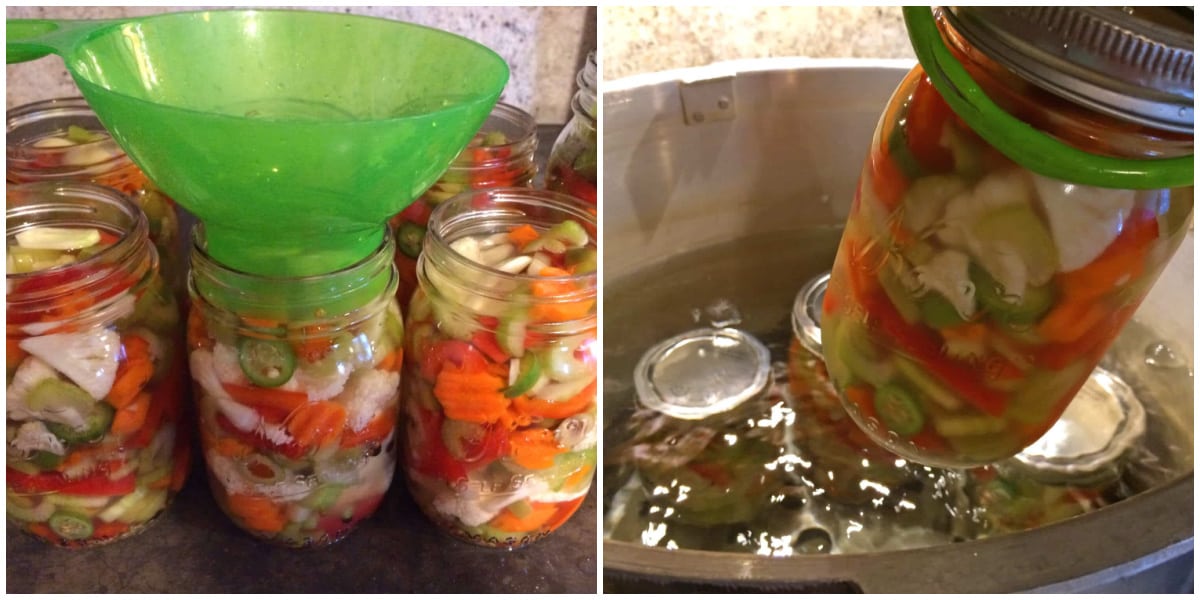
This giardiniera is best eaten after a few days once the flavors have had time to meld. Once opened, store the jar in the fridge where it will keep for up to 2 weeks.
Enjoy!
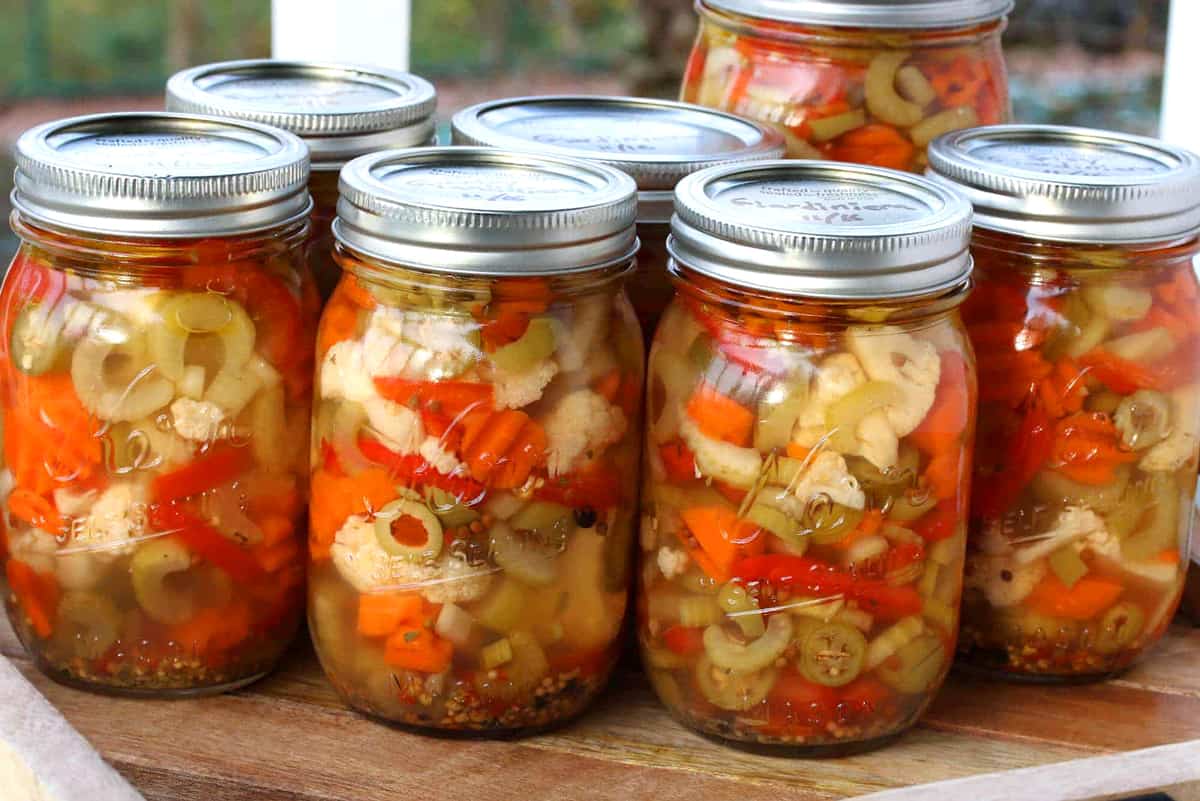
Ways to Enjoy It
Giardiniera can be used in various ways to add a zesty and crunchy element to your dishes. And it’s delicious on its own straight out of the jar. Here are a just few ways you can incorporate giardiniera into your foods:
- Sandwiches and Wraps: It adds a nice crunchy texture and a burst of flavor to the mix. And of course it’s a MUST in your muffuletta sandwich!
- Salads: Toss giardiniera into salads to provide an extra flavor and crunch. Add some to your Macaroni Salad, Potato Salad, and leafy green salads.
- Pizza and Flatbreads: Sprinkle some over your pizza or flatbread before or after baking. It adds a nice bit of tang, richness, and texture.
- Antipasto Platter: Giardiniera is a classic component of antipasto platters. Arrange it alongside cured meats, cheeses, olives, and other pickled items as part of your cheese and charcuterie board.
- Hot Dogs and Sausages: Use it as a topping for hot dogs, brats and sausages. It’s a fun and tasty alternative to the more traditional toppings.
- Tuna or Chicken Salad: Mix it into tuna or Chicken Salad to give it a zesty kick of flavor and some contrasting texture.
- Omelets and Scrambled Eggs: Fold some into your omelet or scrambled eggs for flavor and crunch.
- Grains, Grain Bowls and Rice Dishes: Incorporate it into your grains, grain salads (like my Greek Wheat Berry Salad), grain bowls, and rice dishes for flavor, color and texture.
- Burgers: Top your burgers with it for a fun and tasty flavor twist.
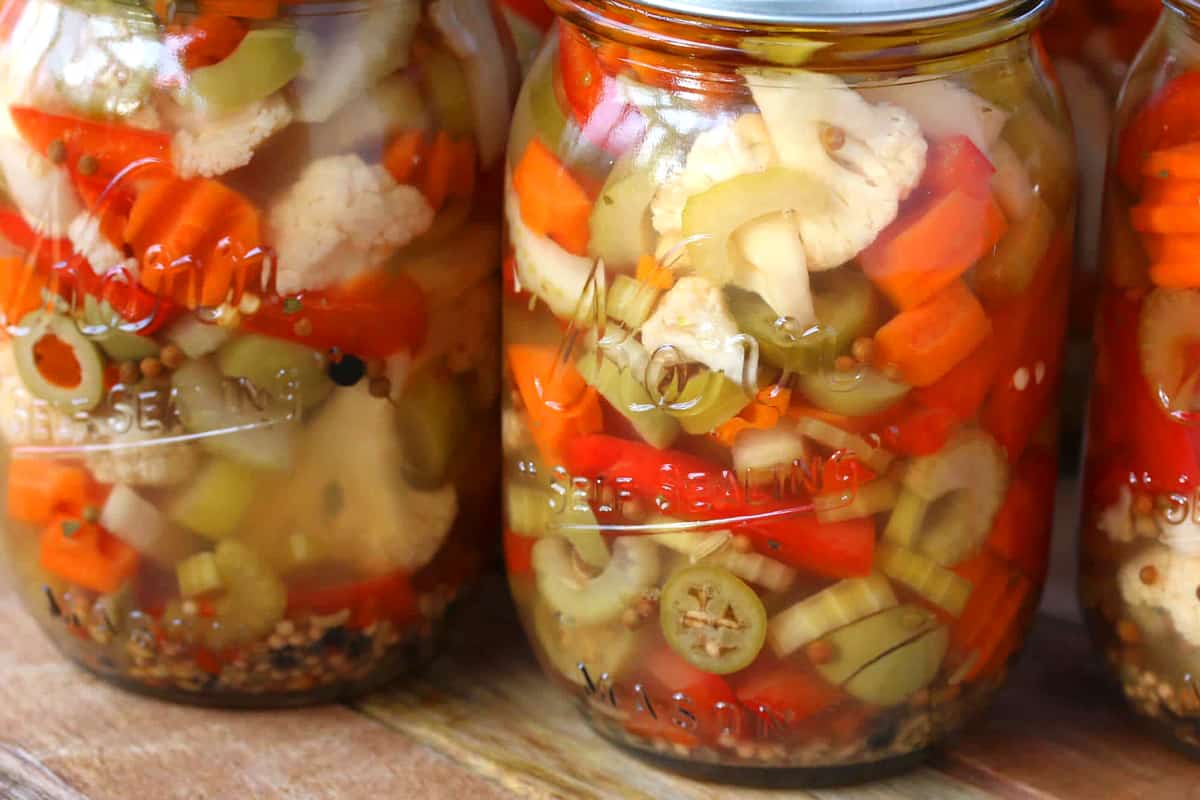
For more great pickled veggie and relish recipes be sure to try my:
- Dill Pickle Relish
- Sweet Pickle Relish
- Sweet Corn Relish
- Sweet Pepper & Onion Relish
- Pickled Onions
- Pickled Okra
- Pickled Banana Peppers
- Pickled Pepperoncini Peppers
- Pickled Green Beans
- Pickled Carrots
- Pickled Jalapenos
- Pickled Beets
Save This Recipe
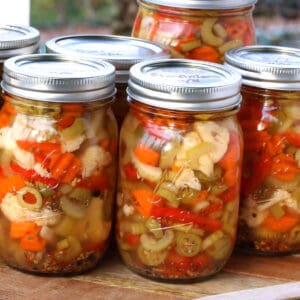
BEST Giardiniera Recipe (Spicy or Mild)
Ingredients
- 1/2 head cauliflower, chopped into small florets
- 10 ribs celery , diced
- 5 carrots , diced
- 2 large red bell peppers , seeded and chopped
- 1 cup sliced green pitted olives
- 4 serrano peppers (or more according to heat preference) , sliced
- Spices/Ingredients for EACH pint jar:
- 1/2 teaspoon dried oregano
- 1/2 teaspoon coriander seeds
- 1/4 teaspoon yellow mustard seeds
- 1/4 teaspoon fennel seeds
- 1/4 teaspoon black peppercorns
- 1/4 teaspoon red chili flakes (optional, for hot giardiniera)
- 1/8 teaspoon celery seeds
- 1 bay leaf
- 1 clove garlic, cut in half
- 1 tablespoon extra virgin olive oil
- For the Brine:
- 4 cups white wine vinegar
- 4 cups water
- 2 tablespoons kosher salt
Instructions
- Place the chopped veggies a large non-reactive pot or bowl. Pour 1/4 cup kosher salt over the vegetables and enough water to cover them. Let the vegetables soak in the salt water for at least 6 hours or overnight.
- To prepare the jars, place the spices into each of the jars, reserving the garlic and olive oil until after the brine is added. (I like to make some jars hot and some mild by adding/omitting the red chili flakes).
- Thoroughly rinse and drain the vegetables before dividing them up between the jars. Pack the vegetables in as tightly as you can. Place a clove of garlic (cut in half) in each jar.
- To make the brine: Bring the water, vinegar and salt to a boil. Pour the boiling brine over the vegetables leaving a little more than 1/2 inch headspace from the top. Pour a tablespoon of olive oil over the top in each jar (omit the oil if water bath canning). Thoroughly wipe the rims with a wet paper towel, ensuring no oil or other residue is on them, and seal the jars.
- If you plan on using the giardiniera within two weeks let the jars sit at room temperature for a day or two and then transfer them to the fridge. The flavor only gets better with time so wait at least 2-3 days before eating it. Will keep refrigerated for 2 weeks.
- If you're canning the giardiniera for long-term storage, seal the jars with the lids and rims and prepare a boiling water bath. Boil the jars for 10 minutes. Carefully remove the jars and let them sit undisturbed for 24 hours before moving them.If processed in the water bath, the giardiniera is best consumed within 6 months but will keep for up to a year.Note: If you're canning the jars for long-term storage you can add the oil later to your giardiniera when you open the jar.
Notes
- At 1,001 to 6,000 feet (305 to 1,829 meters) above sea level: increase processing time by 5 minutes.
- Above 6,000 feet (1,829 meters) above sea level: increase processing time by 10 minutes.
Nutrition
Originally published on The Daring Gourmet August 21, 2017



















insalata molto bella, ne ho comprata una già pronta dall’Italia. Si possono aggiungere i funghi a queste verdure?
Can you add other veggies? Snow peas? Onion? Okra? String beans?
Yes you can, Gail!
Question.. is the canning method a pressure canner that is used? Thank you
Hi Angie, no it’s just a water bath canner.
This is definitely not a Chicago style giardiniera. It’s an oil based product and using vinegar is not allowed.
I was looking this recipe up earlier today, when I noticed at sbcanning.com a picture that looked just like yours? After comparing it, it is your photo, it has your beautiful picture of Giardiniera and then another lesser one comes up, thing is if you are going to use someone else’s photo you would think that the list of ingredients would at lease match what they are showing in the jar. Thought you would find this interesting, or maybe frustrating.
Hi SueV, thanks so much for letting me know. Copyright violations like this (using other people’s images without permission) unfortunately happen far too often :( Hopefully they remove it soon. Thanks again, I appreciate it.
I loved the first bite. So delicious. Then, it tasted like I was eating a lemon. It was so tart that my mouth puckered. I ended up throwing it out. Suggestions? I follow this recipe exactly.
I’m excited to try this recipe, but am wondering, if I pour the brown over, and then due a water bath to seal the container, will the veggies lose their crispness? Should I cool the brine first maybe?
Hi, yes the veggies will lose some of their crispness either way, there’s really no avoiding that if you’re water bathing them. They won’t be mushy though, they will still retain some of their crispness.
Hi Kimberly,
I bought a jar of Giardiniera to use on a Chicago pizza I’m making (Kenji’s NYT recipe this week). It comes from Calabria and the vegetables are packed in oil, not brine. Kenji suggested getting them in oil rather than brine. Can you brine the veggies, but then pack them with oil rather than brine? And then process them? Or is this something that can only be done at a commercial canning factory?
Thanks for your advice.
Kate
Hi Kate, you can do that and then keep them refrigerated, but unfortunately you cannot process them if they’re packed in oil.
Thanks Kim! Good to know.
How do you change the recipe to make 1 large jar instead of several jars?
Hi Sheila, simply put everything, including all the spices you would have put into individual jars, into one large jar instead.
I the amount of spices you have listed in the recipe for each jar? Or is that amount divided up into all the jars?
Thanks
Hi Sy, those are for EACH pint-sized jar.
Can you dice up the vegetables to make it more like a relish? Or will that change the recipe as far as how long to put in water or canning time?
Hi Renee, yes you can and no, there is no need to alter anything else about the recipe or the canning time.
hello, I subscribe to your site, I have done a few of your recipes…
I have a slight correction for you, about it not being well known outside of Chicago or that you are Italian… & that’s not true…
I am Portuguese & living in N.J. since 1970, & this Giardiniera is something that I am familiar since being a child & from overseas… it is served a lot in our ethnic restaurants & our homes all the time as an accompaniment to a meal or as a starter plate with olives, ( etc )… except we spell it with a ” J ” Jardeneira… I love to can & I look forward to trying out this recipe…take care..
I want to make this Giardiniera , but in quart jars. Do i double up on the seasoning ?
Hi Patty, you can put the giardiniera in whichever size jars you prefer without having to alter anything about the ingredients. If you double the recipe you’ll need to double all of the ingredients, including the seasonings.
Do you refrigerate the veggies or leave on counter to soak
Hi Wendy, if it’s room temp I leave it out on the counter.
Do you leave the veg in salt water sit at room temp?
Hi Josey, yes I do.
Thanks! Excellent recipe!
This was fun to make. My only question after finishing was the brine. I had about half of the original amount left over after making 5 pints. I am wondering if I overpacked the veggies. My finished jars did look just like the photo, however.
Hi Michael, how much brine is leftover depends on how tightly you pack the jars and what size of jars you use. As long as the brine is covering the veggies in the jars you’re good to go. Happy eating! :)